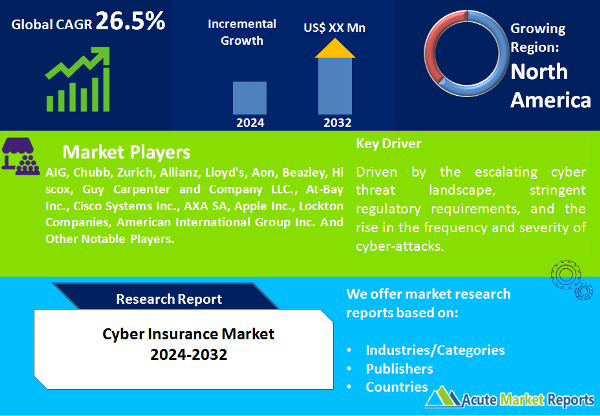
The cyber insurance market is integral to mitigating the financial risks associated with cyber threats and data breaches in the digital era. The cyber insurance market is expected to grow at a CAGR of 26.5% during the forecast period of 2024 to 2032, driven by the escalating cyber threat landscape, stringent regulatory requirements, and the rise in the frequency and severity of cyber-attacks. However, challenges in quantifying cyber risk present a significant restraint. Market segmentation reflects the diverse needs of organizations, with tailored policies expected to gain prominence, and liability coverage anticipating the highest CAGR. Geographically, North America contributes significantly to revenue, while the Asia-Pacific region presents high growth potential. Competitive trends highlight the strategies adopted by major players, including AIG, Chubb, and Zurich. These companies leverage innovation and strategic collaborations to maintain a competitive edge. As the cyber insurance market progresses from 2023 to the forecast period of 2032, continuous adaptation to evolving cyber risks, collaboration with cybersecurity experts, and addressing risk quantification challenges will be critical for sustained success in this crucial aspect of modern risk management.

Escalating Cyber Threat Landscape
The relentless rise in cyber threats, including ransomware attacks, data breaches, and sophisticated cybercrimes, is a primary driver propelling the demand for cyber insurance. Instances like the Colonial Pipeline ransomware attack and the SolarWinds supply chain breach have underscored the pervasive and evolving nature of cyber risks. Organizations, recognizing the financial implications of such incidents, are increasingly investing in cyber insurance to safeguard against potential financial losses. The evidence lies in the surge in cyber insurance purchases by companies across various industries, emphasizing the need for comprehensive coverage to address the dynamic cyber threat landscape.
Stringent Regulatory Requirements
Stringent data protection and cybersecurity regulations globally, such as the GDPR in Europe and the CCPA in California, are compelling organizations to invest in cyber insurance to ensure compliance and mitigate legal and financial risks. Companies like AIG and Chubb have adapted their cyber insurance offerings to align with evolving regulatory landscapes. The evidence lies in the continuous updates and enhancements to policy features, ensuring that organizations have the necessary coverage to comply with regulatory frameworks. The increasing complexity of these regulations and the potential financial consequences of non-compliance drive organizations to seek robust cyber insurance solutions.
Rise in Frequency and Severity of Cyber Attacks
The increasing frequency and severity of cyber-attacks, coupled with the growing sophistication of threat actors, contribute to the rising demand for cyber insurance. High-profile incidents, such as the NotPetya malware attack and the Equifax data breach, have demonstrated far-reaching financial impacts on businesses. Leading insurers like Zurich and Allianz have responded by offering specialized cyber risk assessments and tailored insurance products. The evidence lies in the continuous adaptation of insurance offerings to address emerging cyber threats, showcasing a proactive approach to risk management. As the cyber threat landscape evolves, organizations are recognizing the essential role of cyber insurance in fortifying their resilience against potential financial losses.
Challenges in Quantifying Cyber Risk
Despite the growth of the cyber insurance market, challenges persist in accurately quantifying and assessing cyber risk. Insurers, including Lloyd's and Aon, face difficulties in establishing standardized risk assessment methodologies due to the dynamic and evolving nature of cyber threats. The evidence lies in the complexities associated with predicting the financial impact of a cyber incident, considering factors such as reputational damage and long-term business disruption. While advancements in risk modeling are ongoing, the inherent difficulty in predicting the scope and severity of cyber risks poses a significant restraint. Overcoming this challenge requires continuous collaboration between insurers, cybersecurity experts, and businesses to refine risk assessment methodologies and enhance the industry's overall cyber risk understanding.
Insurance Type Segmentation: Standalone Policies Dominate the Market
In 2023, the highest revenue in the cyber insurance market was generated by standalone policies, offering comprehensive coverage independent of other insurance products. However, the highest Compound Annual Growth Rate (CAGR) during the forecast period (2024-2032) is expected from tailored policies. This dynamic growth is driven by the increasing trend of organizations seeking customized coverage that aligns with their specific cyber risk profiles and business operations. Tailored policies are expected to gain prominence as organizations prioritize a more nuanced and personalized approach to cyber insurance.
Coverage Type Segmentation: First-party Coverage Dominates the Market
First-party coverage led the market in revenue in 2023, encompassing coverage for direct financial losses incurred by the insured organization. However, the highest CAGR during the forecast period is anticipated from liability coverage. The evidence lies in the evolving regulatory landscape, where organizations face increasing legal liabilities and fines related to data breaches. Liability coverage, offered by companies like Beazley and Hiscox, addresses the legal and financial repercussions of third-party claims, reflecting the market's response to the shifting dynamics of cyber risks. This dual segmentation approach reflects the diverse coverage needs of organizations seeking both financial protection and liability mitigation.
North America Remains the Global Leader
Geographically, North America contributed the highest revenue percentage in 2023, driven by the large market and the prevalence of stringent cybersecurity regulations. However, the Asia-Pacific region is poised to exhibit the highest CAGR during the forecast period. The evidence lies in the increasing awareness of cyber risks, regulatory developments, and the growing digitalization of businesses in Asia-Pacific countries. These geographic trends emphasize the need for insurers to tailor their offerings to regional nuances and collaborate with local businesses to address specific cyber risk challenges.
Market Competition to Intensify during the Forecast Period
In 2023, major players in the cyber insurance market included AIG, Chubb, Zurich, Allianz, Lloyd's, Aon, Beazley, Hiscox, Guy Carpenter and Company LLC., At-Bay Inc., Cisco Systems Inc., AXA SA, Apple Inc., Lockton Companies, and American International Group Inc. These companies adopted diverse strategies, including product innovation, risk assessments, and partnerships with cybersecurity firms to enhance their market positions. The evidence lies in AIG's CyberMatics platform, which provides risk insights, and Chubb's collaboration with cybersecurity firms to offer comprehensive risk mitigation services. As of 2023, the competitive landscape indicates a dynamic market where insurers are actively adapting to evolving cyber risks and leveraging technology to provide holistic solutions. Revenues for 2023 and the expected landscape for the forecast period (2024-2032) reveal a competitive environment where market leaders are positioned to address the complex and evolving nature of cyber threats.
Historical & Forecast Period
This study report represents analysis of each segment from 2022 to 2032 considering 2023 as the base year. Compounded Annual Growth Rate (CAGR) for each of the respective segments estimated for the forecast period of 2024 to 2032.
The current report comprises of quantitative market estimations for each micro market for every geographical region and qualitative market analysis such as micro and macro environment analysis, market trends, competitive intelligence, segment analysis, porters five force model, top winning strategies, top investment markets, emerging trends and technological analysis, case studies, strategic conclusions and recommendations and other key market insights.
Research Methodology
The complete research study was conducted in three phases, namely: secondary research, primary research, and expert panel review. key data point that enables the estimation of Cyber Insurance market are as follows:
Market forecast was performed through proprietary software that analyzes various qualitative and quantitative factors. Growth rate and CAGR were estimated through intensive secondary and primary research. Data triangulation across various data points provides accuracy across various analyzed market segments in the report. Application of both top down and bottom-up approach for validation of market estimation assures logical, methodical and mathematical consistency of the quantitative data.
| ATTRIBUTE | DETAILS |
|---|---|
| Research Period | 2022-2032 |
| Base Year | 2023 |
| Forecast Period | 2024-2032 |
| Historical Year | 2022 |
| Unit | USD Million |
| Segmentation | |
Insurance Type
| |
Coverage Type
| |
Enterprise Size
| |
End-User
| |
|
Region Segment (2022-2032; US$ Million)
|
Key questions answered in this report